Hacked away at this for a while today. Here is what I got:
glass.html
<html><head><link rel="stylesheet" type="text/css" href="glass.css"/></head>
<body>
<div id="bkgrd">
<div class="blur-bkgrd-position cropper flip ">
<div class="blur-bkgrd-position glass flip">
</div>
</div>
</div>
</body>
glass.css
#bkgrd{
position:absolute; /*align very top left */
top:0; /*align very top left */
left:0; /*align very top left */
width: 100%; /* full screen for background cover/contain */
padding-top: 56.25%; /* helps "bkgrd-size contain" stretch to full width by breaking height limit */
/*image*/
background-image: url(yourbackground.jpg);
background-size: contain; /*responsive width-wise, no js */
background-repeat: no-repeat;
overflow: hidden;
}
.blur-bkgrd-position {
position:absolute;
top:50%; /*sets up cut off point*/
left:0; /*align very left */
width: 100%; /* full screen for background cover/contain */
padding-top: 56.25%; /* helps "bkgrd-size contain" stretch to full width by breaking height limit */
}
.glass {
/*blurred image*/
background:
/* dark blue */
linear-gradient(
rgba(0, 0, 30, 0.45),
rgba(0, 0, 30, 0.45)
),
url(yourbackground.jpg);
background-size: contain; /*responsive width-wise, no js */
background-repeat: no-repeat;
background-position: center bottom.
-webkit-filter: blur(5px);
-moz-filter: blur(5px);
-o-filter: blur(5px);
-ms-filter: blur(5px);
filter: blur(5px);
}
.cropper {
overflow: hidden; /* performs the cropping */
}
/* apply to both .cropper and .glass */ /* enables crop from the top */
.flip {
-webkit-transform: rotate(180deg);
-moz-transform: rotate(180deg);
-ms-transform: rotate(180deg);
-o-transform: rotate(180deg);
transform: rotate(180deg);
}
Basically, we got two identical background images except one has a tint and blur effect, and is wrapped by an upside-down cropper.
Codepen: http://codepen.io/vtange/pen/MajweX
Helpful link: https://css-tricks.com/crop-top/
